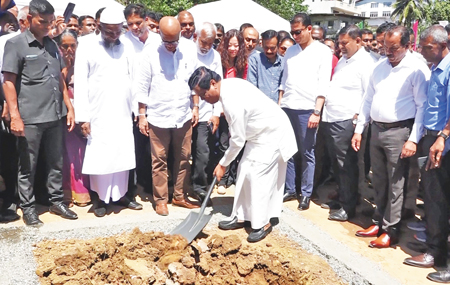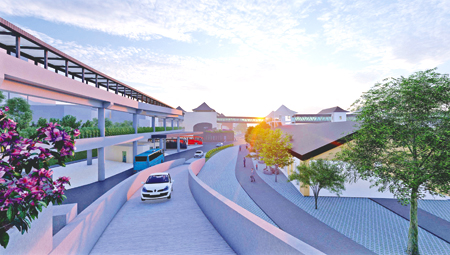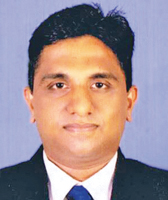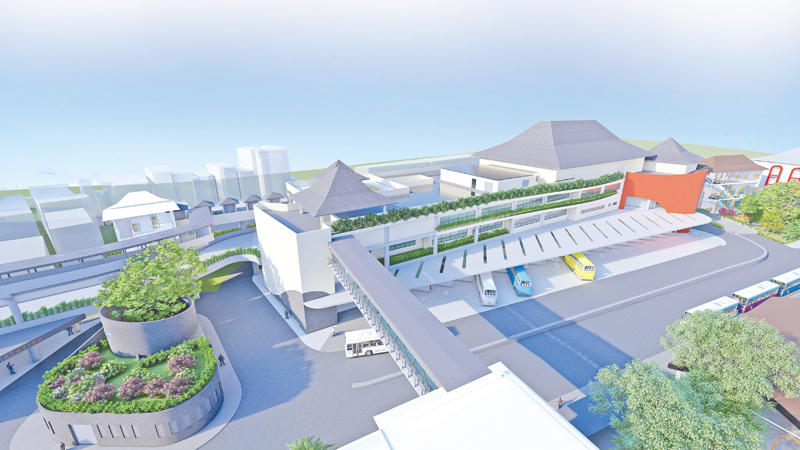- Flyover to reduce congestion
- Destinations extended on 65 bus routes
In 2008, a survey conducted by a group of university students identified Kandy, the capital of the Hill Country, as the most traffic-congested city in Sri Lanka. The findings indicated that entering and exiting the city in the evening requires more than an hour due to severe traffic congestion.

Transport, Highways and Media Minister Dr. Bandula Gunawardena
launches construction work
However, during that period, the focus on addressing the issue might have been limited due to the conflicts in the North and the East. Nonetheless, in 2011, a collaborative study by the University of Moratuwa and the University of Peradeniya revealed significant insights. According to the study, Kandy city witnesses an average weekday influx and outflow of approximately 365,000 passengers (excluding train commuters). Notably, 55 percent of these individuals were found to predominantly rely on public transport services.
The study identified that the city experiences over 5,000 incoming and outgoing bus journeys, highlighting the substantial volume of bus traffic in Kandy.
The survey revealed that to alleviate traffic congestion in Kandy, a strategic solution would involve the construction of a new bus terminal. This proposed terminal would consolidate the starting points of various bus journeys originating from places like Goodshed, Bogambara, Clock Tower, and the Public Market. The recommendation emphasised the importance of designing the terminal as a multimodal transport hub (like the one in Makumbura) to align with modern transportation standards.

The ground floor of the bus terminal
The initial planning for the project commenced in 2015 under the auspices of the Strategic City Development Project the Ministry of Megapolis and Western Development. Subsequently, in 2016, a survey was conducted as part of the ongoing efforts to advance the project.
The Kandy Multimodal Transport Terminal (KMTT) was undertaken as an independent project by the Urban Development Authority (UDA), operating under the Ministry of Urban Development and Housing. Unfortunately, the project faced setbacks due to challenges in meeting the specified targets and was further impeded by the subsequent Covid-19 pandemic that for nearly two years.
However, in 2022, the responsibility for the project was transferred to the Road Development Authority (RDA), under the Ministry of Transport and Highways. This transfer aimed to expedite the implementation of the project.
The initiative, renamed the Kandy Multimodal Transport Terminal Development Project (KMTTDP), is a pivotal step in the development of Kandy. Operating under the Greater Kandy Development Program (GKDP), this project has secured a loan of Rs. 30,000 million from the World Bank, as per the project’s estimated cost.

The entrance to the car park
Under the directives and guidance of the Minister of Transport, Highways, and Mass Media, Dr. Bandula Gunawardena, the Project Management Unit (PMU) established by the RDA, under the Ministry of Transport and Highways, will oversee all management activities related to the KMTTDP.
The RDA has successfully concluded all procurement activities for the project and has awarded the construction contract, valued at Rs. 25,000 million to the MAGA Contracting Company. The consulting firm overseeing the project comprises a collaboration between Roughton, MG Consultant, and ECL.
The project’s proposed timeline was set to commence in January 2024, with the anticipated completion date targeted for December 2026. Accordingly, the project officially commenced on Saturday, January 27, with the participation of Minister Dr. Gunawardena, Fei Deng, South Asia Regional Training Manager of the World Bank, Minister of Investment Promotion Dilum Amunugama, and Ranjith Rubasinghe, the Secretary of the Ministry of Transport and Highways.
The establishment of the KMTTDP aims to address the significant influx of over 5,000 vehicles and approximately 365,000 daily arrivals (nearly 750,000 arrivals and departures) in Kandy City. The project is designed to provide a comprehensive solution to the traffic and transportation challenges.

Project Director R. M. S. J. B. Rathnayake

Transport Consultant Sampath Chandrasena
To gain insights into the matter, the Sunday Observer spoke with the Project Director, R. M. S. J. B. Ratnayake, who is overseeing the KMTTDP.
“The issue of heavy traffic in Kandy has been a longstanding concern, particularly in the central areas like the railway station, main bus station, and other public places that witness high footfall. This congestion is exacerbated by the convergence of multiple main highways, contributing to a worsening situation over time.
Specific challenges are observed during school hours, where school vans tend to cluster near educational institutions around 7.00 in the morning and again in the afternoon. The influx of these vans during this time, contributing to the school drop-off routine, further adds to the traffic congestion in the city,” he said.
“To address the traffic congestion issue in Kandy, a significant step has been taken by temporarily relocating the Goodshed land terminal near the railway station. The entire allocated land has been exclusively dedicated to the KMTTDP. In place of the Goodshed terminal, nine new locations have been introduced as starting points for bus journeys, strategically designed to contribute to the efficient flow of transportation within the city,” he said.
Goodshed Bus Terminal
“The transformation of the Goodshed Bus Terminal in Kandy into the KMBT is a significant development. All buses originating from Kandy will now depart exclusively from this centralised location. Beyond serving as a bus terminal, this facility is designed to cater to various transportation needs, including provisions for railway services and other modes of transport. Additionally, the terminal will offer amenities for cab services, three-wheeler services, and other transportation requirements, creating a comprehensive hub for diverse commuting options,” he said.
According to Sampath Chandrasena, the transport expert for this project, the congestion in Kandy is primarily due to the excessive movement and improper parking of vehicles, notably buses. One potential solution to this issue is to centralise all bus departures from a single location. Additionally, utilising a terminal for multiple bus routes that converge at this central point can contribute to a more organised and streamlined transportation system.

Training Manager, South Asia Zone, World Bank, Faye Deng at the launch
He said that any bus, including long-distance services, is allowed to park at the starting point (Bus Bay) of the terminal for a maximum of 10 minutes only. Within this time frame, it is mandated that all buses should commence their journey from the passenger terminal’s starting point regardless of their passenger load.
To mitigate congestion, the proposed approach involves allowing a bus arriving at the terminal to park only if it initiates its return journey within one hour. If the bus’s return trip extends beyond an hour, it will be relocated to an overflow bus station. The bus will only be recalled to the main terminal when it is approximately an hour away, presenting a systematic method to alleviate congestion, as emphasised by the transport expert.
“Another method, termed “Touch and Go,” involves redirecting several bus destinations that reach Kandy to three locations outside the city: Getambe, Katugastota, and Digana. This approach aims to extend services to these areas, providing passengers travelling beyond Kandy the convenience of continuing their journey on the same bus. Simultaneously, this strategy is anticipated to reduce City traffic. This method facilitates the integration of two bus service routes,” he added.
By implementing this strategy, approximately 65 percent of the buses that previously remained within Kandy will now exit the City without delay. This significant change is expected to play a crucial role in alleviating the existing traffic congestion.
There are plans to construct a new sky bridge spanning approximately 200 metres, connecting Sirimavo Bandaranaike Mawatha and William Gopallawa Mawatha. This infrastructure project aims to discourage public movement along the highway and provide a faster means for people to reach their destinations. Access roads will be developed to facilitate quick travel for passengers heading to the Kandy General Hospital (KGH) and the railway station from this flyover.
As part of this development, plans include the rehabilitation of the terminal’s internal access road system and the central canal section that runs through the Goodshed Bus Station. The construction of the new bridge is designed to ensure accessibility for individuals with disabilities, allowing them to travel using wheelchairs.
The implementation of this project is structured around five main factors. These include the construction of the primary three-story KMTT main building, the bus stop building, and an Arcade building designed to offer facilities to the public. A comprehensive digital technology-based management system will be established as an integral part of the project.
The project aims to cater to the needs of over 150 buses by providing essential service facilities for buses and their crews. This includes accommodation facilities, rest areas, and specially designated safe zones for women. Other associated companies and means of transport will also be equipped with the necessary facilities to enhance overall transport services.

The overhead bridge from the bus terminal
towards Sirimavo Bandaranaike Mawatha.
(The railway station is not depicted in the picture)
Moreover, the terminal will serve as a hub where people can access the latest information regarding passenger transport buses. Train-related information will be readily available at multiple transport terminals. The implementation of technical information tools and a dedicated operational control centre within the terminal will ensure the provision of modern information and technology tools for the buses and passengers arriving at the terminal.
The implementation of the project will have a significant impact on the Sri Lanka Railways, leading to the displacement of the largest amount of land and necessitating the demolition of residences for railway employees. In response, measures will be taken to offer temporary housing and establish a 7-storey building for their permanent resettlement.
It is anticipated that following the completion of the transport terminal, the percentage of passengers arriving in Kandy via public transport will rise to 60 percent or more.
Kandy attracts a substantial number of foreign tourists daily. The constraints posed by the lake on one side and the Queens Hotel on the other make it impossible to widen the road in front of the Sacred Temple of the Tooth Relic (Sri Dalada Maligawa). The construction of the new multimodal transport terminal has carefully taken all these factors into consideration to address the unique challenges presented by the city’s topography and the influx of foreign visitors.
Apart from the ongoing project, there was initially a plan to implement an underground pathway in the central area of Kandy. However, there is currently an assessment under way to determine the necessity of constructing an elevated pathway instead. This study aims to explore alternative transportation solutions that best suit the unique terrain, requirements and conditions of Kandy.
In conjunction with the ongoing project, a study is being conducted to assess the feasibility of developing the railway line as a double railway line. This evaluation stems from the recognition that prolonged stops of buses in front of the railway crossings in the City, caused by an increasing number of trains, may lead to decreased productivity. Although this study is separate from the current project, it is being conducted concurrently to ensure a comprehensive approach to addressing the transportation challenges in Kandy. This will also help reduce air pollution caused by private vehicles in Kandy, as more people are likely to opt for public transport.
Translated by Maneshka Borham








